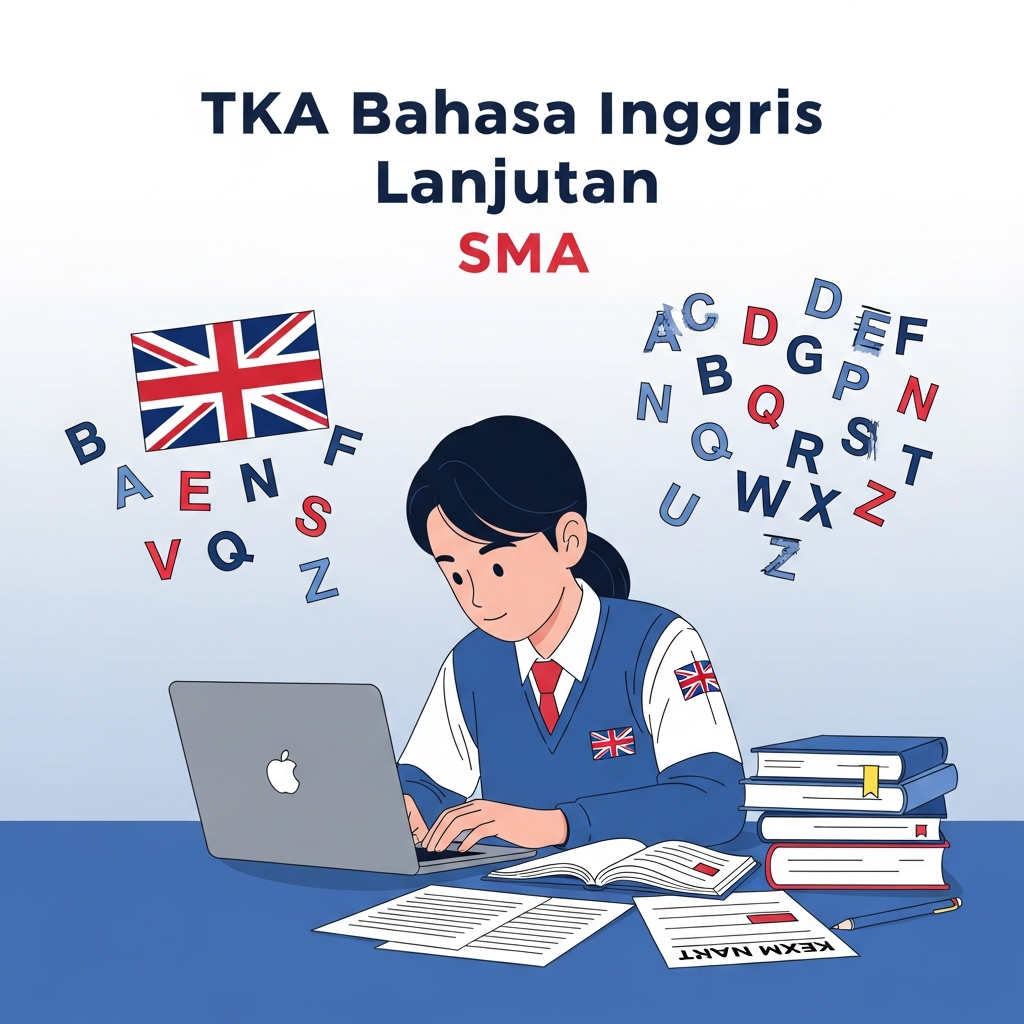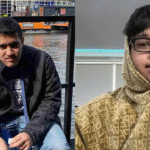
Menghadapi Tes Kemampuan Akademik (TKA) 2025 membutuhkan persiapan yang matang, terutama untuk mata uji pilihan. Salah satu yang paling diminati adalah TKA Bahasa Inggris Lanjutan, yang dirancang untuk mengukur kemampuan berbahasa Inggris pada level akademik. Berbeda dari Bahasa Inggris wajib, soal pada level ini menuntut pemahaman yang lebih mendalam terhadap teks kompleks, struktur kalimat, dan kosakata yang lebih luas.
Memahami kisi-kisi TKA Bahasa Inggris lanjutan dan berlatih secara rutin adalah kunci untuk meraih skor maksimal. Latihan soal tidak hanya membiasakan Anda dengan format ujian, tetapi juga mempertajam kemampuan analisis dan manajemen waktu. Artikel ini akan membahas secara lengkap kisi-kisi materi, 50 contoh soal TKA 2025 untuk Bahasa Inggris Lanjutan, serta pembahasan soal TKA yang mudah dipahami.

Kisi-Kisi TKA Bahasa Inggris Lanjutan 2025
Secara garis besar, kisi-kisi TKA Bahasa Inggris Lanjutan berfokus pada Reading Comprehension (Pemahaman Bacaan) dalam level yang lebih tinggi (setara CEFR B1-B2).
Berikut adalah cakupan materi dan tipe soal yang akan Anda hadapi:
- Jenis Teks yang Diujikan: Teks yang digunakan relevan dengan konteks akademik, dunia kerja, dan isu sosial. Jenis teksnya meliputi:
- Descriptive: Mendeskripsikan orang, tempat, atau benda.
- Recount: Menceritakan kembali sebuah peristiwa atau pengalaman.
- Narrative: Teks cerita (fiksi atau non-fiksi) dengan alur.
- Procedure: Menjelaskan langkah-langkah melakukan sesuatu.
- Analytical Exposition/Argumentative: Teks yang menyajikan argumen untuk meyakinkan pembaca.
- Tipe Pertanyaan Utama: Kemampuan Anda akan diuji melalui tiga kategori pertanyaan utama :
- General Information (Informasi Umum):
- Menentukan Main Idea (Gagasan Utama) paragraf atau keseluruhan teks.
- Menentukan Purpose (Tujuan Penulis).
- Menentukan Summary (Ringkasan) atau Title (Judul) yang tepat.
- Menentukan Author’s Tone (Sikap/Nada Penulis).
- Specific Information (Informasi Spesifik):
- Menemukan Detailed Information (Informasi Rinci) yang tersurat dalam teks.
- Menentukan Synonym/Vocabulary (Makna Kata) sesuai konteks.
- Menentukan Referent (Rujukan Kata), misalnya “it”, “they”, “this” merujuk ke mana.
- Memverifikasi pernyataan True/False (Benar/Salah).
- Implied Information (Informasi Tersirat):
- Membuat Inference (Kesimpulan) berdasarkan bukti di teks.
- Menentukan Assumption (Asumsi) penulis.
- Membuat Prediction (Prediksi) tentang topik paragraf selanjutnya.
- General Information (Informasi Umum):
Tips Singkat:
- Skimming: Gunakan teknik membaca cepat ini untuk mendapatkan gambaran umum teks, biasanya untuk menjawab soal Main Idea atau Purpose.
- Scanning: Gunakan teknik ini untuk mencari informasi spesifik (seperti nama, tanggal, atau angka) dengan cepat.
- Baca Soal Dulu: Membaca pertanyaan sebelum membaca teks dapat membantu Anda fokus mencari jawaban yang relevan saat membaca
50 Contoh Soal TKA Bahasa Inggris Lanjutan dan Pembahasannya
Berikut adalah kumpulan latihan soal TKA Bahasa Inggris Lanjutan yang dirancang untuk membantu Anda mempersiapkan diri
Grammar & Structure
Soal-soal ini menguji pemahaman Anda tentang struktur kalimat yang sering muncul dalam teks akademik.
- If the company had managed its resources better, it… bankrupt last year.
A. would not go
B. would not have gone
C. will not go
D. did not go
E. had not gonePembahasan: Ini adalah Conditional Sentence Type 3 (pengandaian masa lalu). Rumusnya adalah
If + Past Perfect,... would have + V3.
Kunci Jawaban: B - The manager demanded that all employees… on time for the mandatory meeting.
A. are
B. were
C. be
D. being
E. have beenPembahasan: Ini adalah bentuk Subjunctive. Setelah kata kerja yang menunjukkan tuntutan (seperti demand, suggest, require), klausa
thatdiikuti oleh Subject + Verb 1 (bare infinitive).
Kunci Jawaban: C - …. its high price, the new smartphone sold millions of units in its first week.
A. Although
B. Despite
C. However
D. Because
E. In order toPembahasan: “its high price” adalah sebuah frasa kata benda (noun phrase). Despite digunakan sebelum noun phrase, sedangkan Although digunakan sebelum klausa (Subject + Verb).
Kunci Jawaban: B - “More than two billion cups of coffee are drunk every day and for many, working life would feel impossible without it.” The modal ‘would’ in this context shows…
A. a request
B. a habit in the past
C. a possibility
D. a hypothetical situation
E. a wishPembahasan: Modal “would” di sini digunakan untuk menggambarkan situasi hipotetis (pengandaian), yaitu bagaimana rasanya “bekerja tanpa kopi”.
Kunci Jawaban: D - The scientist… research won the Nobel Prize studied the effects of climate change.
A. who
B. which
C. whom
D. whose
E. thatPembahasan: Kata “whose” digunakan untuk menunjukkan kepemilikan (penelitian milik ilmuwan tersebut).
Kunci Jawaban: D - Identify the incorrect word in the following sentence: The professor, along with (A) his three top students (B), are (C) scheduled (D) to present the findings (E).
A. along with
B. his three top students
C. are
D. scheduled
E. the findingsPembahasan: Subjek utama kalimat adalah “The professor”. Frasa “along with his three top students” hanyalah pelengkap. Subjek tunggal (“professor”) membutuhkan kata kerja tunggal (“is”, bukan “are”).
Kunci Jawaban: C - The victim was unable to identify the man… attacked her.
A. who
B. whom
C. whose
D. which
E. wherePembahasan: “who” digunakan sebagai subjek (orang yang melakukan serangan) yang merujuk pada “the man”. Kunci Jawaban: A
- Not only… the exam, but he also received a distinction for his project.
A. he passed
B. did he pass
C. he did pass
D. passed he
E. he has passedPembahasan: Ini adalah struktur inversi (inversion) setelah “Not only…”. Pola yang benar adalah
Not only + auxiliary verb + subject + main verb.
Kunci Jawaban: B - The data collected from the survey… insufficient to draw a firm conclusion.
A. is
B. are
C. were
D. have been
E. wasPembahasan: Kata “data” adalah bentuk jamak dari “datum”. Namun, dalam penggunaan modern, “data” sering diperlakukan sebagai kata benda kolektif (tak terhitung) yang tunggal, terutama dalam konteks formal/akademik. Akan tetapi, jika “data” merujuk pada kumpulan poin individu, “are/were” (jamak) lebih tepat. Dalam konteks TKA, “data” sebagai jamak (plural) sering diuji. “Data… are… insufficient”. Namun, jika dianggap satu kesatuan informasi, “is” juga bisa diterima. Catatan: Kunci jawaban TKA sering kali lebih menyukai “data” sebagai jamak. Mari kita asumsikan “data” merujuk pada banyak poin data.
Kunci Jawaban: B (atau C, tergantung konteks lampau/sekarang. Mari gunakan B untuk konteks umum). - My manager suggested… a new marketing strategy to attract more customers.
A. to develop
B. develop
C. developing
D. developed
E. to be developingPembahasan: Kata kerja “suggest” diikuti oleh Gerund (Verb-ing) jika tidak ada klausa ‘that’.
Kunci Jawaban: C - The committee is looking for a person with integrity, creativity, and…
A. they are reliable
B. reliability
C. reliable
D. is reliable
E. being reliablePembahasan: Ini adalah soal Parallelism. “Integrity” (noun), “creativity” (noun), dan harus diikuti oleh “reliability” (noun).
Kunci Jawaban: B - By the time the ambulance arrived, the patient… consciousness.
A. already lost
B. has already lost
C. had already lost
D. loses
E. was losing
Pembahasan: Past Perfect (had + V3) digunakan untuk menunjukkan aksi yang terjadi sebelum aksi lampau lainnya (ambulance arrived).
Kunci Jawaban: C - This is the first time I… a traditional Japanese tea ceremony.
A. have ever experienced
B. experienced
C. am experiencing
D. will experience
E. had experienced
Pembahasan: Ungkapan “This is the first time…” diikuti oleh Present Perfect (have + V3).
Kunci Jawaban: A - The artist’s work is difficult…, but it is also incredibly rewarding to analyze.
A. to understand
B. understand
C. understanding
D. understood
E. for understanding
Pembahasan: Pola “difficult + to + infinitive” digunakan untuk menjelaskan mengapa sesuatu itu sulit.
Kunci Jawaban: A - Identify the incorrect word in the following sentence: The (A) ancient ruins, (B) which includes (C) a temple and an amphitheater, (D) attract thousands of (E) tourists each year.
A. The
B. ancient ruins
C. includes
D. attract
E. touristsPembahasan: Kata “which” merujuk pada “ancient ruins” (jamak). Oleh karena itu, kata kerja yang mengikutinya harus jamak (“include”, bukan “includes”).
Kunci Jawaban: C
Vocabulary in Context (16-25)
Soal-soal ini menguji kemampuan Anda memahami makna kata atau frasa dalam konteks bacaan.
- “Conservation efforts are crucial to mitigate the impacts of climate change on vulnerable species.” The word “mitigate” is closest in meaning to…
A. Increase
B. Understand
C. Reduce
D. Ignore
E. Exacerbate
Pembahasan: “Mitigate” berarti mengurangi keparahan atau dampak negatif dari sesuatu.
Kunci Jawaban: C - “The word nefarious in paragraph 2 is closest in meaning to…” (Konteks: Biasanya merujuk pada aktivitas ilegal atau jahat)
A. Evil
B. Helpful
C. Necessary
D. Complicated
E. SecretivePembahasan: “Nefarious” berarti jahat, kriminal, atau tidak bermoral.
Kunci Jawaban: A - “The word ‘barred’ in paragraph two can be best replaced by…” (Konteks: Sesuatu yang menghalangi jalan)
A. Blocked
B. Opened
C. Unsealed
D. Decorated
E. AllowedPembahasan: “Barred” berarti terhalang atau tertutup.
Kunci Jawaban: A - “What is a synonym for the word ‘integral‘ in the text?” (Konteks: Technology has become an integral part of our lives)
A. Unimportant
B. Essential
C. Optional
D. Insignificant
E. SecondaryPembahasan: “Integral” berarti sangat penting atau esensial, menjadi bagian yang tak terpisahkan.
Kunci Jawaban: B - “What is the opposite of ‘vulnerable‘ as used in the passage?” (Konteks: Vulnerable species)
A. Resilient
B. Endangered
C. Fragile
D. Exposed
E. SensitivePembahasan: “Vulnerable” berarti rentan. Lawan katanya adalah “resilient”, yang berarti tangguh atau mampu bertahan.
Kunci Jawaban: A - “According to the passage, coffee is proven to have many perks…” The word “perks” is closest in meaning to…
A. Disadvantages
B. Benefits
C. Dangers
D. Ingredients
E. Problems
Pembahasan: “Perks” (singkatan dari perquisites) adalah manfaat atau keuntungan tambahan.
Kunci Jawaban: B - “AI can handle repetitive, monotonous tasks without fatigue…” The word “handle” can be best replaced by…
A. Manage
B. Create
C. Avoid
D. Change
E. InterruptPembahasan: “Handle” dalam konteks ini berarti mengelola atau melaksanakan tugas.
Kunci Jawaban: A - “Early human remains are scarce in the region…” The word “scarce” is closest in meaning to…
A. Common
B. Plentiful
C. Rare
D. Important
E. VisiblePembahasan: “Scarce” berarti langka atau sulit ditemukan.
Kunci Jawaban: C - “During the dig, the find took on a whole new level of intrigue…” The word “intrigue” means the quality of being…
A. Dangerous
B. Valuable
C. Boring
D. Fascinating
E. OldPembahasan: “Intrigue” berarti sesuatu yang sangat menarik atau memancing rasa ingin tahu.
Kunci Jawaban: D - “The Oromo people from Ethiopia are thought to have been the first to have noticed the stimulating effects of these ‘beans’…” The word “stimulating” means…
A. Calming
B. Energizing
C. Poisonous
D. Flavorful
E. Sleep-inducing
Pembahasan: Efek “stimulating” dari kopi adalah yang memberi energi atau membuat terjaga.
Kunci Jawaban: B
Reading Comprehension
Passage 1 (Soal 26-30) Teks berikut untuk soal 26-30. AI is increasingly used in various areas of life, including the workplace. While some support this development, others express concern. Supporters present three main points. First, efficiency and productivity. AI can handle repetitive, monotonous tasks without fatigue, allowing employees to focus on more complex and creative work. Second, better decision-making. AI can analyze vast amounts of data quickly, identifying patterns that help managers make informed decisions. Third, learning and development. AI can enhance employee engagement by offering personalized training and detecting skill gaps.
Critics, however, raise several concerns. First, job displacement. As AI takes over tasks once handled by humans, there’s growing fear of job loss. Second, lack of human touch. AI cannot replicate the empathy and emotional intelligence offered by human leaders. Third, ethical and privacy issues. Concerns about data use require clear policies to ensure fairness and transparency, maintaining employee trust.
- The second paragraph of the text mainly discusses AI as…
A. a tool to enhance workplace productivity and employee growth.
B. the cause of job losses and emotional stress among workers.
C. a system that replaces human leaders in decision-making.
D. a machine incapable of human empathy and connection.
E. the threat to employee’s privacy and data security.Pembahasan: Paragraf kedua (Supporters) fokus pada poin-poin positif AI, yaitu efisiensi (productivity) dan pengembangan karyawan (employee growth).
Kunci Jawaban: A - What is the author’s purpose in writing this text?
A. To argue that AI is more beneficial than harmful.
B. To criticize companies that refuse to adopt AI.
C. To present a balanced view of AI’s impact in the workplace.
D. To warn employees about the dangers of AI.
E. To explain how AI technology functions.
Pembahasan: Teks ini menyajikan sisi “supporters” (paragraf 2) dan “critics” (paragraf 3), menunjukkan pandangan yang seimbang (pro dan kontra).
Kunci Jawaban: C - According to the text, what can AI not do?
A. Analyze large amounts of data.
B. Handle repetitive tasks.
C. Offer personalized training.
D. Identify patterns in data.
E. Replicate human empathy.
Pembahasan: Paragraf ketiga dengan jelas menyatakan, “AI cannot replicate the empathy and emotional intelligence”.
Kunci Jawaban: E - The word “monotonous” in paragraph 2 is closest in meaning to…
A. Difficult
B. Boring
C. Important
D. Creative
E. ComplexPembahasan: “Monotonous” berarti membosankan karena berulang-ulang.
Kunci Jawaban: B - What can be inferred from the text about tasks that are less likely to be replaced by AI?
A. Tasks that are repetitive and monotonous.
B. Tasks that require data analysis.
C. Tasks that involve physical labor.
D. Tasks that require creativity and emotional intelligence.
E. Tasks that involve numbers and patterns.Pembahasan: Teks menyatakan AI mengambil alih tugas monoton (paragraf 2) dan kurang dalam empati/kreativitas (paragraf 2 & 3). Jadi, pekerjaan yang aman adalah yang membutuhkan kreativitas dan empati.
Kunci Jawaban: D
Passage 2 (Soal 31-35) Teks berikut untuk soal 31-35.
There are many habits I’ve gained while working from home: snacking when desired, taking the dog for a midmorning walk, and settling in for a daily nap. That last one will be especially painful to give up if or when I return to an office; my naps have become essential downtime. Why do my naps feel so needed and so revitalising?
There are two biological processes that contribute to daily drowsiness. The first system is the circadian: It prompts you to stay awake when it’s light out and asleep when it’s dark. In the middle of the day, it causes the hormone cortisol to start decreasing. The second is the homeostatic: It makes you sleepier the longer you’ve been awake. As the day progresses, it continually increases your “sleep pressure.” Together, at midday, these create “kind of a perfect storm that makes people tired.”
For many people who are sleep-deprived, a short shut-eye session is the ticket. “Your mood gets better, your creativity, your perceptual processing, your memory processing.” Mednick has found that nappers perform as well on a pattern-recognition task as people who have slept overnight. Naps can boost and restore brain power. Toddlers who nap express more joy. Adults nappers can tolerate frustration longer. Naps may help protect older people from cognitive decline.
- What is the main topic of the passage?
A. The author’s work-from-home habits.
B. The biological causes of tiredness and the benefits of napping.
C. The differences between circadian and homeostatic systems.
D. The negative effects of sleep deprivation.
E. How to nap effectively during work.Pembahasan: Paragraf 1 memperkenalkan “napping”, paragraf 2 menjelaskan mengapa kita lelah (biologi), dan paragraf 3 menjelaskan manfaat tidur siang (benefits).
Kunci Jawaban: B - What do processes in paragraph 2 tell us about our body?
A. The sleep pressure is one of our body’s weaknesses.
B. Sleep is a relaxing mechanism of the brain.
C. The body regulates sleep through biological processes.
D. There are two ways for our body to take a nap.
E. We can control the body’s need for sleep in two ways.Pembahasan: Paragraf 2 menjelaskan dua proses biologis (circadian dan homeostatic) yang mengatur rasa kantuk kita.
Kunci Jawaban: C - Which question is answered by paragraph 3?
A. Why do many people take naps?
B. What are the benefits of naps?
C. What are the drawbacks of taking naps?
D. What makes naps better than sleeping overnight?
E. How long should a nap be?Pembahasan: Paragraf 3 (dan 4, yang tidak dikutip penuh di sini tapi dirujuk ) berisi daftar manfaat: mood lebih baik, kreativitas, memori, toleransi frustrasi, dll.
Kunci Jawaban: B - The phrase “a perfect storm” in paragraph 2 means…
A. A dangerous weather condition.
B. A situation where two things conflict.
C. A rare biological event.
D. A combination of factors leading to a specific result.
E. A feeling of extreme tiredness.Pembahasan: “A perfect storm” adalah idiom yang berarti kombinasi beberapa faktor (circadian dan homeostatic) yang bersama-sama menciptakan satu hasil spesifik (rasa kantuk di tengah hari).
Kunci Jawaban: D - What can we conclude from the effects of taking a nap discussed in the text?
A. The effects of napping include both psychological and physiological advantages.
B. If done correctly, napping can have a huge range of health benefits.
C. Children are more affected by naps than adults are.
D. Napping is only for people who are sleep-deprived.
E. Napping makes you better at pattern-recognition only.Pembahasan: Teks menyebutkan berbagai manfaat: mood, kreativitas (psikologis) dan perlindungan dari cognitive decline (fisiologis). Pilihan B merangkum luasnya manfaat (“huge range”) yang dibahas.
Kunci Jawaban: B
Passage 3 (Soal 36-40) Teks berikut untuk soal 36-40.
More than two billion cups of coffe are drunk every day and for many, working life and feel impossible without it. As traditionally tea-dringking countries like China are seduced by coffee’s charms, it may soon become the world’s favourite drink. What is driving this insatiable thirst, and how has the beverage come to conquer the world? Coffee’s story starts in the lush highlands of Ethiopia, the natural homeland of the delicate Coffee arabice plant. Although they are called “coffee beans”, the plant is not a legume, and the fruits of the coffee tree look more like cherries when they are first picked. The seeds inside are extracted and dried before the process of roasting turns them into the hard, nutty nodules we feed into our grinders.
The Oromo people from Ethiopia are thought to have been the first to have noticed the stimulating effects of these “beans”, and coffee still remains an important element of their traditional cuisine. Exactly how and when it spread beyond Ethiopia is still the subject of many legends, but the available historic records suggest that the Sufis of Yemen were the first truly devoted drinkers outside Africa in the Middle Ages.
Its caffeine helped them to continue thei practices late into the night, while the roasting of the bean was apparently taken as an analogy for the transcendence of the human soul. Coffee houses soon spread across the Middle East and the Ottoman Empire, where they caught the attention of Western traders, who took the beguiling drink back to their home countries in the 17th Century. (…).
One newspaper advert in 1678 described thee drink as “having many excellent virtues, closes the orifice of the stomach, fortifies the heart within, helps digestion, brights up the spirit.” created by hellsxnki on twitter Some studies suggest that coffee can offer some protection from certain common diseases. A recent review of the evidence by Susanna Larsson at the Karolinska Institute in Sweden found that each cup of coffee per day is associated with a 6% reduction in the risk of type 2 diabetes. Laura Van Dongen at Wageningen University, meanwhile, has found that regular coffee drinkers were at least 20% less likely to die from heart disease. source: bbc.com
- According to the text, which statement is true?
A. Coffee beans are a type of legume.
B. Western traders discovered coffee in Ethiopia.
C. The Oromo people were the first to roast coffee.
D. Coffee fruits look like cherries when picked.
E. Sufis in Yemen used coffee to sleep better.Pembahasan: Paragraf 1 menyatakan, “the plant is not a legume, and the fruits… look more like cherries”.
Kunci Jawaban: D - The word “beguiling” in paragraph 3 is closest in meaning to…
A. Harmful
B. Bitter
C. Charming
D. Expensive
E. CommonPembahasan: “Beguiling” berarti menawan, memesona, atau sangat menarik (charming), yang membuat para pedagang Barat tertarik membawanya pulang.
Kunci Jawaban: C - Where did Western traders first encounter coffee houses?
A. In Ethiopia
B. In Yemen
C. In the Middle East and the Ottoman Empire
D. In their home countries
E. In AfricaPembahasan: Paragraf 3 menyatakan, “Coffee houses soon spread across the Middle East and the Ottoman Empire, where they caught the attention of Western traders”.
Kunci Jawaban: C - What can be inferred about the spread of coffee?
A. It was a very quick and immediate process.
B. It was primarily driven by religious practices.
C. It followed major trade routes.
D. It was kept secret by the Oromo people for centuries.
E. It stopped after reaching the Ottoman Empire.Pembahasan: Teks menyebutkan penyebaran dari Ethiopia -> Yemen -> Middle East -> Western traders. Ini menunjukkan penyebaran yang mengikuti alur perdagangan dan interaksi budaya.
Kunci Jawaban: C - According to the passage, why was coffee particularly useful to the Sufis in Yemen?
A. It was an important part of their traditional cuisine.
B. Its caffeine helped them remain awake during nightly rituals.
C. The roasted bean was an analogy for the human soul.
D. It helped them manage type 2 diabetes.
E. It was brought to them by Western traders.Pembahasan: Teks tersebut secara eksplisit menyatakan pada paragraf keempat, “Its caffeine helped them to continue their practices late into the night…” (Kafeinnya membantu mereka melanjutkan praktik/ritual mereka hingga larut malam). Pilihan B adalah jawaban yang paling akurat yang merangkum informasi ini.
Kunci Jawaban: B
Passage 4 (Soal 41-45) Teks berikut untuk soal 41-45.
A complete skeleton of a 19- or 20-year-old Homo sapiens was found during 2020 excavations at a site called Liang Tebo, in remote eastern Kalimantan. Early human remains are scarce in the region. During the dig, the find took on a whole new level of intrigue as the team discovered that the skeleton’s lower leg was entirely missing. The limb had been not broken, but cleanly removed, and the archaeologists found unusual bony overgrowth on the remaining fragments. That overgrowth matched overgrowth seen in modern clinical cases of amputations.
Further investigations showed that the bone developed atrophy, indicating the part of the limb that remained was a stump with limited use. Investigations into this remodeling of bone structure showed some six to nine years of such changes. “This confirms that the surgery was not fatal, not infected and likely occurred during late childhood,” says Tim Maloney, a co-author of the study.
To perform a successful operation, prehistoric surgeons must have had knowledge of anatomy. What seems certain, however, is that the patient enjoyed a considerable level of post-op care. “It is highly unlikely that this individual could have survived the procedure without intensive nursing care, including blood loss and shock management, and regular wound cleaning,” Maloney notes.
- What is the main discovery described in the passage?
A. The oldest Homo sapiens skeleton ever found.
B. A new excavation site in Kalimantan called Liang Tebo.
C. Evidence of a successful, complex surgical amputation in prehistoric times.
D. The first human remains found in the region of eastern Kalimantan.
E. A new type of bone overgrowth previously unknown to science.Pembahasan: Penemuan utamanya bukanlah kerangkanya, melainkan fakta bahwa kerangka itu menunjukkan amputasi bedah (surgical amputation) yang sukses dan canggih di zaman prasejarah.
Kunci Jawaban: C - Which information indicates the assertion that the early human survived the suggested amputation?
A. The skeleton does not include a lower leg part.
B. The bone of the amputated leg shrunk in size (atrophy).
C. The amputated part was cleanly removed.
D. The bone remodeling showed six to nine years of changes.
E. The skeleton was 19 or 20 years old.Pembahasan: Teks menyatakan “six to nine years of such changes” (remodeling tulang) pasca-operasi. Ini membuktikan individu tersebut hidup lama (6-9 tahun) setelah amputasi.
Kunci Jawaban: D - The passage suggests that the prehistoric community…
A. was primitive and lacked medical knowledge.
B. frequently performed surgical procedures.
C. had a complex social structure that included caring for the sick.
D. avoided surgery due to high risks of infection.
E. lived in large, established cities.Pembahasan: Kebutuhan akan “intensive nursing care” (perawatan pasca-operasi) menyiratkan bahwa komunitas tersebut merawat anggotanya yang sakit atau terluka.
Kunci Jawaban: C - The word “considerable” in paragraph 3 means…
A. Minor
B. Significant
C. Unnecessary
D. Brief
E. BasicPembahasan: “Considerable level of post-op care” berarti tingkat perawatan yang signifikan, besar, atau substansial.
Kunci Jawaban: B - What is the author’s tone in this passage?
A. Skeptical
B. Humorous
C. Critical
D. Informative and amazed
E. SadPembahasan: Penulis menyajikan fakta-fakta (informatif) tetapi juga menggunakan kata-kata seperti “intrigue” dan “considerable” untuk menunjukkan kekaguman (amazed) pada penemuan tersebut.
Kunci Jawaban: D
Passage 5 (Soal 46-50) Teks berikut untuk soal 46-50. Malin had always dreamed of leaving his small coastal village. He moved to Jakarta with hopes of building a better life. He worked part-time jobs during the day and studied digital marketing at night. His hard work paid off, and he eventually became a successful CEO of a startup, known for his “humble beginnings” story.
One day, during a public event, an old woman approached him, calling him her son. He gave her a quick nod and turned away, pretending not to recognize her. Later that night, a short video went viral: a young CEO ignoring an old woman who claimed to be his mother. Comments exploded with criticism, and people began to question the authenticity of his “humble” background. Sponsorships were paused. Interview requests stopped coming. Alone in his apartment, Malin stared at the screen—his face frozen in the moment he turned away.
- What is the main message of the story?
A. Building your image is part of surviving in a competitive world.
B. Ambition can push you to make difficult personal choices.
C. Success means little if it leads you to ignore those who supported you.
D. Staying true to your goals is more important than pleasing others.
E. Digital marketing is the key to success in Jakarta.Pembahasan: Inti cerita ini adalah kejatuhan Malin. Kesuksesannya (menjadi CEO) hancur seketika ketika dia mengabaikan ibunya (orang yang mendukungnya/asal-usulnya).
Kunci Jawaban: C - What is the consequence of Malin’s action at the event?
A. His mother cursed him into stone.
B. He received praise for his professionalism.
C. He decided to return to his village.
D. His public image and business were severely damaged.
E. He hired the old woman as an employee.Pembahasan: Teks menyatakan “Comments exploded with criticism… Sponsorships were paused.” Ini menunjukkan citra dan bisnisnya rusak. (Pilihan A adalah pengecoh dari legenda aslinya).
Kunci Jawaban: D - What would likely happen if Malin didn’t ignore his mother, but treated her with respect in front of the public?
A. People would question whether he was faking the moment for attention.
B. His mother would ask him to return to the village.
C. He would lose brand deals for being too focused on family.
D. It would strengthen his image as someone who truly came from humble beginnings.
E. The event would not have gone viral.Pembahasan: Citra publik Malin dibangun di atas cerita “humble beginnings” (latar belakang sederhana). Menghormati ibunya akan memperkuat (strengthen) citra tersebut, bukan merusaknya.
Kunci Jawaban: D - Determine whether the following statement is True or False based on the passage: “Malin became successful through dedication and hard work.”
A. True
B. FalsePembahasan: Teks menyatakan, “He worked part-time jobs… and studied… at night. His hard work paid off… he eventually became a successful CEO”. Ini jelas menunjukkan kerja keras.
Kunci Jawaban: A - The word “authenticity” in paragraph 2 means…
A. Genuineness
B. Popularity
C. Wealth
D. Weakness
E. AmbitionPembahasan: Orang-orang mempertanyakan “authenticity” (keaslian atau ketulusan) dari cerita “latar belakang sederhananya” setelah ia mengabaikan ibunya.
Kunci Jawaban: A
Tips Mengerjakan TKA Bahasa Inggris Lanjutan
Untuk memaksimalkan hasil saat mengerjakan soal TKA Bahasa Inggris Lanjutan, terapkan 5 tips strategis berikut saat menghadapi TKA 2025:
- Baca Pertanyaan Terlebih Dahulu
Trik ini sangat menghemat waktu. Dengan membaca soal dulu, Anda tahu informasi apa yang harus dicari di dalam teks. Ini mengubah Anda dari pembaca pasif menjadi pemburu informasi aktif. - Kuasai Teknik Skimming dan Scanning
Jangan baca setiap kata. Gunakan Skimming (membaca cepat) untuk mendapatkan ide utama teks. Gunakan Scanning (memindai) untuk mencari kata kunci, nama, atau angka spesifik saat menjawab soal detail. - Manajemen Waktu adalah Kunci
Tes ini memiliki batas waktu yang ketat. Tentukan batas waktu maksimal untuk setiap soal (misalnya, 90 detik). Jika Anda terjebak di satu soal sulit, segera beralih ke soal lain. Jangan sampai kehabisan waktu. - Gunakan Teknik Eliminasi Jawaban
Jika Anda ragu, gunakan teknik eliminasi. Coret pilihan jawaban yang jelas-jelas salah (misalnya, terlalu ekstrem, tidak relevan, atau bertentangan dengan teks). Ini akan meningkatkan peluang Anda memilih jawaban yang benar dari opsi yang tersisa. - Perbanyak Kosakata Akademik
Semakin banyak Anda membaca, semakin kaya kosakata Anda. Fokuslah pada kosakata yang sering muncul dalam konteks akademik dan berita. Memahami kosakata dalam konteks (vocabulary in context) adalah keterampilan yang sangat diuji dalam tes ini.
Penutup
Menghadapi TKA Bahasa Inggris Lanjutan memang menantang, namun bukan berarti tidak bisa ditaklukkan. Kunci kesuksesan terletak pada pemahaman pola soal dan latihan yang konsisten.
Gunakan kumpulan soal di atas sebagai bahan evaluasi untuk melihat di mana kekuatan dan kelemahan Anda. Teruslah berlatih dengan berbagai jenis teks agar Anda terbiasa dengan tingkat kesulitan dan tekanan waktu. Semoga sukses dalam persiapa TKA 2025!
Lihat juga contoh soal TKA selain TKA Bahasa Inggris Lanjutan:
https://blog.amikom.ac.id/tag/kumpulan-soal-tka
50 Kumpulan Soal TKA Bahasa Indonesia Lanjut SMA Lengkap dengan Pembahasan dan Kunci Jawaban







